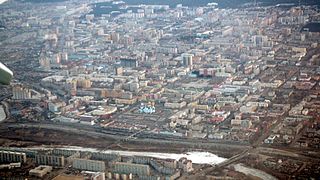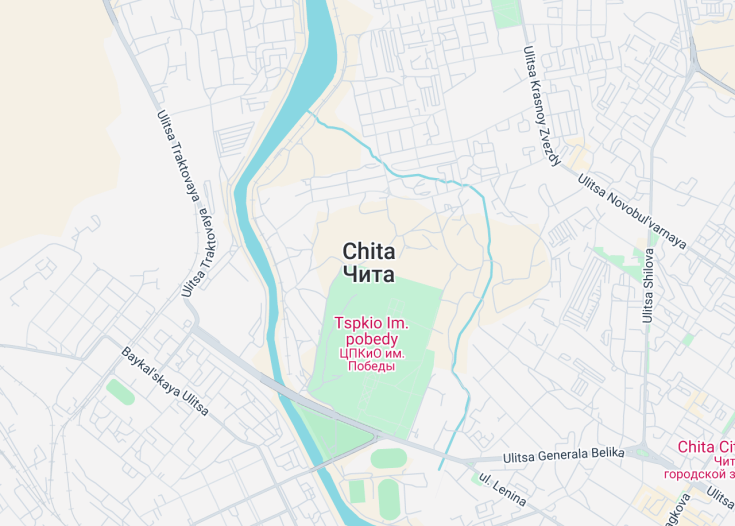Chita, located in Eastern Siberia, Russia, serves as the administrative center of Zabaykalsky Krai. This historically rich city, once a key transit point on the Decembrists’ route to Siberian exile, offers visitors a blend of cultural heritage and natural beauty.
Surrounded by vast forests and the nearby Chikoy and Ingoda rivers, Chita presents a unique opportunity to explore the rugged landscapes and delve into Russia’s intricate past. The city’s museums, theaters, and buddhist temples provide a deep dive into the cultural tapestry that defines this region.
For those considering Chita, pack adequately for its harsh, continental climate: cold winters and warm, brief summers require versatile clothing.
A well-planned visit to Chita should include exploring the city’s extensive railway history at the Chita Railroad Museum, especially enlightening for history buffs.
Top things to do & see in Chita
Select the following sights and activities to discover best tickets and tours available in Chita.
Chita: Gateway to Siberia
| Country | Russia |
| Time in Chita | GMT+9 |
| Language spoken | Russian |
| Population | 349,257 (2023 estimate, provided by the Russian Federal State Statistics Service) |
| Currency | Russian Ruble (₽, RUB) |
| Airports |
|
Located in eastern Siberia, Chita is a city steeped in history and cultural significance. As the administrative center of the Zabaykalsky Krai, Chita acts as a major hub linking the Trans-Siberian Railway and the Transbaikalian region. The city’s geographical positioning as a gateway to the extensive Siberian wilderness affords it strategic importance, while its historical backdrop narrates tales of exiles and tsarist political prisoners during the late 19th and early 20th centuries.
The cityscape of Chita is marked by Soviet-era architecture and relics of its tumultuous past, including the Decembrist Church Museum, dedicated to the memory of the Decembrists exiled to Siberia after their unsuccessful revolt against Tsar Nicholas I in 1825. Besides its historical allure, Chita is surrounded by vast natural resources, including forestry and minerals, which play a crucial role in its economy and lifestyle of its residents.
Chita’s climate is sharply continental, with harsh winters and warm summers, customary of its Siberian location. This climatic condition molds the lifestyle of its inhabitants and offers unique seasonal activities for visitors, from ice fishing and hunting to summer festivals celebrating local culture and heritage. For adventurers and history buffs alike, Chita presents an intriguing mixture of natural beauty and historical depth, making it a compelling destination for those looking to explore beyond conventional tourist routes in Russia.
Where is Chita?
Located in the heart of Siberia, Chita lies to the east of Lake Baikal, nestled among extensive pine forests and rolling hills.
Distances:
| Route | Distance by car | Time by car |
|---|---|---|
| Moscow to Chita | 3,900 miles | Approx. 68 hours |
| Irkutsk to Chita | 625 miles | Approx. 12 hours |
What is Chita famous for?
Chita is renowned for its significant historical connection as a place of exile during tsarist Russia and a pivotal stop along the Trans-Siberian Railway.
History
Pre-18th Century: Indigenous Roots and Russian Exploration
The history of Chita begins with the indigenous tribes of the Daur people, who predominantly inhabited the area. The strategically located city on the Chita River was initially an exploration ground for Russian Cossacks in the later part of the 17th century, seeking routes to expand the burgeoning Siberian fur trade. This early contact paved the way for subsequent settlements.
19th Century: Establishment and Expansion
Chita officially emerged on the historical map in 1821 when it was founded as a small Russian fort town. It evolved rapidly with the construction of the Trans-Siberian Railway in the late 19th century, linking Chita with the far reaches of the Russian Empire and promoting population growth through the influx of settlers, traders, and exiles, including the Decembrists, political prisoners exiled after their failed uprising against Tsar Nicholas I in 1825.
Early 20th Century: Revolution and Change
The early 20th century was a tumultuous period for Chita, experiencing the waves of the Russian Revolution. Following the 1917 Bolshevik rise to power, Chita became a stronghold for anti-communist White Army forces during the Russian Civil War. It was the capital of the short-lived Far Eastern Republic from 1920 to 1922, a buffer state between Soviet Russia and Imperial Japan.
Late 20th Century: Soviet Era and Military Importance
Under Soviet rule, Chita saw significant industrial and military development owing to its strategic location near Russia’s eastern borders. The presence of military installations and the establishment of various industries shaped much of the city’s economy and structure, with Chita becoming a closed city due to its critical military significance during the Cold War.
21st Century: Modern Developments and Challenges
Post-Soviet Chita has grappled with economic transformation and social changes, transitioning from a militarized economy to a more diversified one, yet facing issues like population decline and economic disparities. Despite these challenges, Chita continues to embrace its historical heritage, while progressively integrating into the broader economic and cultural fabric of modern Russia.
Visit Chita
What to see and do in Chita, Russia
When visiting Chita, explore its rich history and cultural heritage. Key attractions include the Chita Regional Art Museum, which showcases Russian and local art, and the Decembrist’s Church Museum, which tells the poignant story of the exiled Decembrists.
Nature enthusiasts can visit the nearby Alkhanai National Park, known for its unique geological formations and spiritual significance to local indigenous peoples. For a real taste of local life, stroll through Lenin Square and indulge in local Siberian cuisine at the bustling city markets.
- Chita Regional Art Museum
- Decembrist’s Church Museum
- Alkhanai National Park
- Lenin Square and local markets
Annual Events in Chita
Chita plays host to several cultural and historical events throughout the year. Notable among them is the City Day celebration in September, featuring parades, folk performances, and local cuisine showcases. Winter enthusiasts can enjoy the Winter Festival in December, with ice sculptures and Siberian winter sports.
Best time to visit Chita
Chita experiences a harsh continental climate, with cold winters and hot summers. The best time to visit is during the late spring (May to June) when temperatures are moderate and the natural landscapes are most vibrant, or during early autumn (September to October) for pleasant weather and fewer crowds.
Is Chita worth visiting?
Chita offers a unique glimpse into Russia’s complex history and diverse cultures, making it a worthwhile destination for those interested in exploring beyond the conventional tourist routes.
While its remote location and climate extremes can pose challenges, the city’s rich historical sites, cultural events, and the natural beauty of the surrounding regions provide compelling reasons to visit. However, travelers should be prepared for a more rugged experience compared to more developed tourist cities in Europe or Asia.










